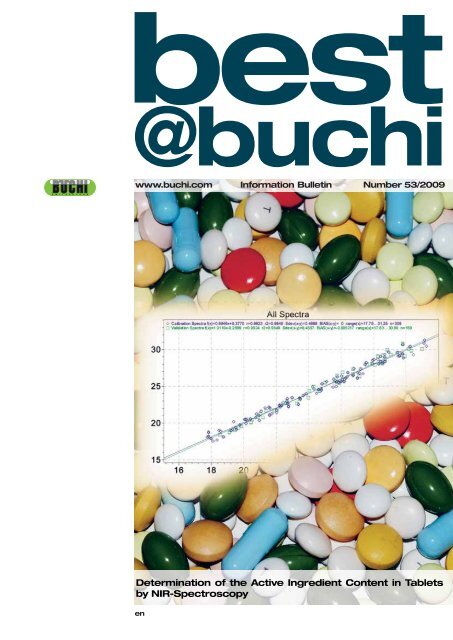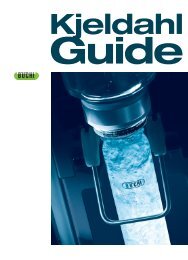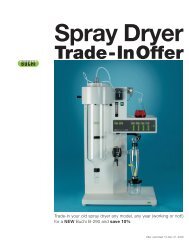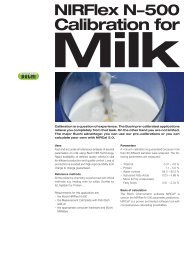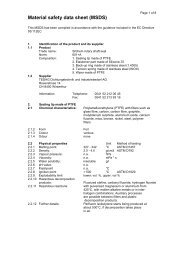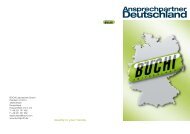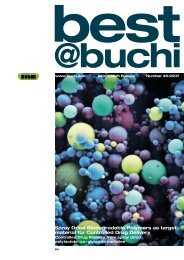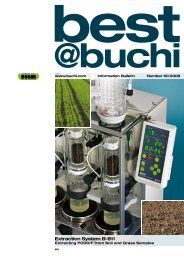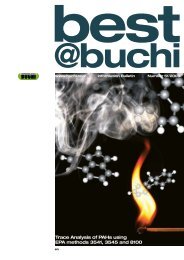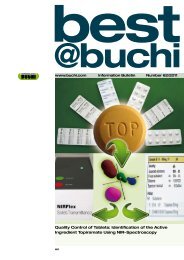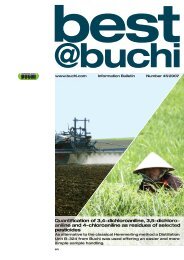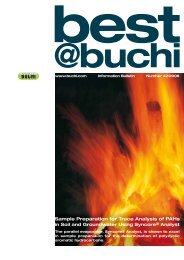Determination of the Active Ingredient Content in Tablets by NIR ...
Determination of the Active Ingredient Content in Tablets by NIR ...
Determination of the Active Ingredient Content in Tablets by NIR ...
You also want an ePaper? Increase the reach of your titles
YUMPU automatically turns print PDFs into web optimized ePapers that Google loves.
est<br />
@buchi<br />
www.buchi.com Information Bullet<strong>in</strong> Number 53/2009<br />
<strong>Determ<strong>in</strong>ation</strong> <strong>of</strong> <strong>the</strong> <strong>Active</strong> <strong>Ingredient</strong> <strong>Content</strong> <strong>in</strong> <strong>Tablets</strong><br />
<strong>by</strong> <strong>NIR</strong>-Spectroscopy<br />
en
est@buchi 53/ 2009 en<br />
Creation <strong>of</strong> a Calibration for <strong>the</strong> <strong>Determ<strong>in</strong>ation</strong> <strong>of</strong> <strong>the</strong> <strong>Active</strong><br />
<strong>Ingredient</strong> <strong>Content</strong> <strong>of</strong> <strong>Tablets</strong> <strong>by</strong> <strong>NIR</strong>-Spectroscopy<br />
Authors: Nadja Doll (Dipl.Ing.(FH)),<br />
Lydia Lehwald (Dipl.Ing.(FH)),<br />
Company: Salutas Pharma GmbH,<br />
D-Barleben<br />
In order to create a precise and robust<br />
calibration model for determ<strong>in</strong><strong>in</strong>g <strong>the</strong><br />
active <strong>in</strong>gredient content <strong>of</strong> tablets, it is<br />
essential to choose a suitable calibration<br />
range. This range should cover at<br />
least 75 -125% <strong>of</strong> <strong>the</strong> nom<strong>in</strong>al content<br />
<strong>of</strong> <strong>the</strong> active <strong>in</strong>gredient <strong>in</strong> 5% steps, <strong>in</strong><br />
order to achieve sufficient accuracy <strong>of</strong><br />
<strong>the</strong> calibration model. In <strong>the</strong> follow<strong>in</strong>g<br />
<strong>the</strong> creation <strong>of</strong> two calibration models is<br />
described.<br />
These calibration models were created<br />
us<strong>in</strong>g two different types <strong>of</strong> tablets.<br />
Captopril 25 mg tablets are clover-leaf<br />
shaped tablets and have an active <strong>in</strong>gredient<br />
content <strong>of</strong> 25 mg and a total weight<br />
<strong>of</strong> 160 mg. Ramipril 2.5 mg tablets are<br />
oblong (4mm x 8mm), are engraved on<br />
one side, conta<strong>in</strong> 2.5 mg active <strong>in</strong>gredient<br />
and have a total weight <strong>of</strong> 80 mg.<br />
Manufacture <strong>of</strong> <strong>the</strong> blends<br />
for <strong>the</strong> calibration set<br />
For manufactur<strong>in</strong>g <strong>of</strong> Captopril 25 mg<br />
tablets and Ramipril 2.5 mg tablets used<br />
<strong>in</strong> <strong>the</strong>se <strong>in</strong>vestigations, 2kg <strong>of</strong> blend<br />
mass was used for each calibration<br />
step. Care was taken to ensure that <strong>the</strong><br />
<strong>in</strong>ternal manufactur<strong>in</strong>g <strong>in</strong>structions were<br />
accurately applied. Thus at a later date<br />
<strong>the</strong> calibration models could be used for<br />
<strong>the</strong> determ<strong>in</strong>ation <strong>of</strong> <strong>the</strong> active <strong>in</strong>gredient<br />
content <strong>of</strong> <strong>the</strong> tablets from rout<strong>in</strong>e<br />
production. As <strong>the</strong>se were pilot scale<br />
batches, a pilot scale gravity blender<br />
was used to prepare <strong>the</strong> different<br />
blends.<br />
Tablett<strong>in</strong>g <strong>of</strong> <strong>the</strong> various<br />
blends<br />
As two different types <strong>of</strong> tablet presses<br />
(Kilian or FETTE Compact<strong>in</strong>g) are used<br />
<strong>in</strong> <strong>the</strong> rout<strong>in</strong>e production <strong>of</strong> Captopril<br />
25 mg and Ramipril 2.5 mg tablets,<br />
<strong>the</strong>se different tablet presses have to<br />
be taken <strong>in</strong>to consideration <strong>in</strong> <strong>the</strong> manufacture<br />
<strong>of</strong> <strong>the</strong> sample tablets. For<br />
this reason, half <strong>of</strong> <strong>the</strong> blend mixtures<br />
were tabletted on a Kilian and <strong>the</strong> o<strong>the</strong>rs<br />
on a FETTE tablet press. In this<br />
way, it was also possible to manufacture<br />
a large number <strong>of</strong> sample tablets.<br />
Pilot scale tablet presses were used<br />
for <strong>the</strong> preparation <strong>of</strong> <strong>the</strong> calibration<br />
samples.<br />
Use <strong>of</strong> <strong>the</strong> tablets conta<strong>in</strong><strong>in</strong>g<br />
100 % active <strong>in</strong>gredient<br />
content from rout<strong>in</strong>e production<br />
As rout<strong>in</strong>e production naturally aims<br />
only to produce tablets <strong>of</strong> 100% active<br />
<strong>in</strong>gredient content, <strong>the</strong> spectra <strong>of</strong><br />
tablets from rout<strong>in</strong>e production with<br />
“100% active <strong>in</strong>gredient content”<br />
should also be recorded and taken<br />
<strong>in</strong>to consideration dur<strong>in</strong>g <strong>the</strong> compilation<br />
<strong>of</strong> <strong>the</strong> calibration model. These<br />
tablets were also subjected to HPLC<br />
analysis to determ<strong>in</strong>e <strong>the</strong> active <strong>in</strong>gredient<br />
content. <strong>Tablets</strong> that were compressed<br />
on different tablet presses<br />
showed perceivable differences <strong>in</strong><br />
<strong>the</strong>ir physical properties, such as porosity<br />
and hardness, which <strong>in</strong>fluence<br />
<strong>the</strong> spectra. In order to achieve a robust<br />
calibration model, it is <strong>the</strong>refore<br />
essential to also use tablets from <strong>the</strong><br />
production when creat<strong>in</strong>g <strong>the</strong> calibration<br />
model.<br />
Record<strong>in</strong>g <strong>of</strong> spectra and<br />
determ<strong>in</strong>ation <strong>of</strong> active<br />
<strong>in</strong>gredient content <strong>by</strong> HPLC<br />
After <strong>the</strong> tablets were pressed, <strong>the</strong><br />
spectra were recorded. Here, special<br />
care was taken to take all possible orientations<br />
<strong>of</strong> <strong>the</strong> tablets <strong>in</strong>to consideration.<br />
This is particularly important as<br />
some tablets have engrav<strong>in</strong>gs or break<br />
scores. These different characteristics<br />
<strong>of</strong> <strong>the</strong> tablets have to be <strong>in</strong>cluded <strong>in</strong><br />
<strong>the</strong> calibration, to make it sufficiently<br />
robust. The spectra were recorded on<br />
a Büchi <strong>NIR</strong>Flex N-500 us<strong>in</strong>g <strong>the</strong> solid<br />
transmittance module. For both tablet<br />
types, customized sample tablet trays<br />
with 30 tablet nests were made to ensure<br />
high reproducibility and to avoid<br />
stray light. From each sample, (different<br />
tablet presses, different active <strong>in</strong>gredient<br />
manufacturers, different concentration<br />
levels), <strong>the</strong> spectra were<br />
recorded as triplicates. In this way,<br />
more than 100 spectra were recorded<br />
for each calibration step.<br />
The <strong>NIR</strong>Ware Operator s<strong>of</strong>tware was<br />
used to record <strong>the</strong> spectra <strong>in</strong> a range <strong>of</strong><br />
11.520 to 6.000 cm -1 us<strong>in</strong>g 64 scans.<br />
Diag.: 1: Example <strong>of</strong> spectra recorded for Captopril 25 mg tablets<br />
After record<strong>in</strong>g <strong>the</strong> spectra, <strong>the</strong> active <strong>in</strong>gredient content <strong>of</strong> <strong>the</strong> tablet was determ<strong>in</strong>ed<br />
us<strong>in</strong>g a validated HPLC method. The active <strong>in</strong>gredient content was <strong>the</strong>n attributed to<br />
<strong>the</strong> appropriate spectra.
Creation <strong>of</strong> a calibration model us<strong>in</strong>g <strong>the</strong><br />
recorded spectra and <strong>the</strong> assay<br />
results from <strong>the</strong> laboratory<br />
<strong>NIR</strong>Cal 5 Chemometric-s<strong>of</strong>tware was used to create <strong>the</strong><br />
calibration model. The PLS-method was used to calculate<br />
<strong>the</strong> calibration <strong>of</strong> <strong>the</strong> Captopril 25 mg und Ramipril 2.5 mg<br />
tablets. Diagrams 2 and 3 show <strong>the</strong> calibrations for<br />
Captopril 25 mg and Ramipril 2.5 mg tablets.<br />
Predicted Property Gehalt Captopril<br />
B<br />
Predicted Property vs. Orig<strong>in</strong>al Property<br />
30<br />
25<br />
20<br />
15<br />
All Spectra<br />
Calibration Spectra<br />
f(x)=0.9846x+0.3770 r=0.9923 r2=0.9846 Sdev(x-y)=0.4668 BIAS(x-y)= 0 range(x)=17.75 .. 31.25 n=309<br />
Validation Spectra<br />
f(x)=1.0110x-0.2699 r=0.9924 r2=0.9849 Sdev(x-y)=0.4597 BIAS(x-y)=-0.005217 range(x)=17.83 .. 30.99 n=159<br />
16 18 20 22 24 26 28 30 32<br />
Orig<strong>in</strong>al Property Gehalt Captopril<br />
Diagram: 2: Calibration for Captopril 25 mg<br />
Diagram: 3: Calibration for Ramipril 2.5 mg<br />
Quantitative <strong>NIR</strong>-Calibrations are normally evaluated <strong>by</strong><br />
different, exactly def<strong>in</strong>ed parameters. Precision, accuracy,<br />
coefficient <strong>of</strong> regression r, <strong>the</strong> Q-value and <strong>the</strong> consistency<br />
have to be taken <strong>in</strong>to consideration.<br />
Evaluation <strong>of</strong> <strong>the</strong> calibration models<br />
for Captopril 25 mg and Ramipril 2.5 mg<br />
tablets<br />
From <strong>the</strong> results shown <strong>in</strong> tables 1 and 2 for <strong>the</strong> evaluation <strong>of</strong><br />
<strong>the</strong> calibration models for Captopril 25 mg and Ramipril 2.5 mg,<br />
it is evident that <strong>the</strong>se are accurate, precise and robust calibration<br />
models.<br />
Table 1: Results <strong>of</strong> <strong>the</strong> calibration for Captopril 25 mg<br />
Parameter C-Set V-Set<br />
Precision<br />
SEC<br />
0.47<br />
SEP<br />
0.46<br />
Accuracy (BIAS) 0 0.005<br />
Regression coefficient r 0.9923 0.9924<br />
Q-Value 0.85<br />
Consistency 101.5<br />
Table 2: Results <strong>of</strong> <strong>the</strong> calibration for Ramipril 2.5 mg<br />
Parameter C-Set V-Set<br />
Precision<br />
SEC<br />
0.19<br />
SEP<br />
0.18<br />
Accuracy (BIAS) 0 0.017<br />
Regression coefficient r 0.8971 0.8975<br />
Q-Value 0.74<br />
Consistency 106.5<br />
Both are found to be very suitable for use <strong>in</strong> <strong>the</strong> determ<strong>in</strong>ation<br />
<strong>of</strong> <strong>the</strong> active <strong>in</strong>gredient content. Robust calibration<br />
models are characterized <strong>by</strong> <strong>the</strong> fact that <strong>the</strong> error <strong>of</strong> prediction<br />
for <strong>the</strong> calibration samples and <strong>of</strong> <strong>the</strong> validation samples<br />
are comparable. This is shown <strong>by</strong> <strong>the</strong> SEC- and SEP-values<br />
as well as <strong>by</strong> <strong>the</strong> consistency value. Moreover, <strong>the</strong><br />
diagrams and <strong>the</strong> BIAS values show that <strong>the</strong>re is a very good<br />
correlation between <strong>the</strong> HPLC values and <strong>the</strong> <strong>NIR</strong> predictions.<br />
Therefore, <strong>in</strong> addition to high precision, <strong>the</strong> calibration models<br />
exhibit very good accuracy.<br />
Validation <strong>of</strong> <strong>the</strong> calibration<br />
Validation is described as <strong>the</strong> process <strong>of</strong> verify<strong>in</strong>g a method.<br />
For this purpose, <strong>the</strong> method is <strong>in</strong>vestigated to determ<strong>in</strong>e<br />
whe<strong>the</strong>r it provides reproducible and reliable results under <strong>the</strong><br />
conditions described. By divid<strong>in</strong>g <strong>the</strong> spectra <strong>of</strong> <strong>the</strong> calibration<br />
set and <strong>the</strong> validation set, <strong>the</strong> s<strong>of</strong>tware <strong>in</strong>dependently carries<br />
out an <strong>in</strong>ternal validation. Various guidel<strong>in</strong>es require that a<br />
method is validated with <strong>the</strong> aid <strong>of</strong> a calibration, a validation<br />
and a test-set. This requirement was fulfilled <strong>by</strong> determ<strong>in</strong><strong>in</strong>g <strong>the</strong><br />
active <strong>in</strong>gredient content <strong>of</strong> additional tablets <strong>by</strong> <strong>NIR</strong>-spectroscopy.<br />
For comparison, <strong>the</strong>se tablets were also <strong>in</strong>vestigated<br />
us<strong>in</strong>g <strong>the</strong> validated HPLC method to determ<strong>in</strong>e <strong>the</strong> active<br />
<strong>in</strong>gredient content. In table 3, <strong>the</strong> results <strong>of</strong> 6 Captopril 25 mg<br />
tablets with an expected active <strong>in</strong>gredient content <strong>of</strong> 25 mg<br />
are compared. For <strong>the</strong> Ramipril 2.5 mg tablets with an<br />
expected active <strong>in</strong>gredient content <strong>of</strong> 2.5 mg <strong>the</strong> comparison<br />
results <strong>of</strong> <strong>the</strong> 6 tablets are presented <strong>in</strong> table 4.<br />
best@buchi 53 / 2009 en
est@buchi 53/ 2009 en<br />
Table 3: Comparison <strong>of</strong> <strong>the</strong> <strong>NIR</strong>-Method with <strong>the</strong> HPLC-Method<br />
for Captopril 25 mg tablets<br />
Captopril<br />
25 mg<br />
Table 4: Comparison <strong>of</strong> <strong>the</strong> <strong>NIR</strong>-Method with <strong>the</strong> HPLC-Method<br />
for Ramipril 2.5 mg tablets<br />
Ramipril<br />
2.5 mg<br />
BÜCHI Labortechnik AG<br />
Postfach<br />
9230 Flawil 1<br />
Schweiz<br />
T +41 71 394 63 63<br />
F +41 71 394 65 65<br />
buchi@buchi.com<br />
www.buchi.com<br />
BUCHI Corporation<br />
19 Lukens Drive, Suite 400<br />
New Castle<br />
Delaware 19720<br />
USA<br />
T +1 302 652 3000<br />
F +1 302 652 8777<br />
Toll Free: +1 877 692 8244<br />
us-sales@buchi.com<br />
www.mybuchi.com<br />
BÜCHI Labortechnik GmbH<br />
Postfach 10 03 51<br />
45003 Essen<br />
Deutschland<br />
Freecall 0800 414 0 414<br />
T +49 201 747 490<br />
F +49 201 237 082<br />
deutschland@buchi.com<br />
www.buechigmbh.de<br />
BUCHI Hong Kong Ltd.<br />
1810 Fortress Tower<br />
250 K<strong>in</strong>g’s Road<br />
North Po<strong>in</strong>t, Hong Kong<br />
Ch<strong>in</strong>a<br />
T +852 2389 2772<br />
F +852 2389 2774<br />
ch<strong>in</strong>a@buchi.com<br />
www.buchi.com.cn<br />
We are represented <strong>by</strong> more than 100 distribution<br />
partners worldwide. F<strong>in</strong>d your local representative at<br />
www.buchi.com<br />
<strong>NIR</strong><br />
[ mg]<br />
<strong>NIR</strong><br />
[ mg]<br />
HPLC<br />
[ mg]<br />
HPLC<br />
[ mg]<br />
Deviation<br />
[%]<br />
1 25.605 25.523 0.32<br />
2 26.061 25.739 1.25<br />
3 26.095 25.959 0.52<br />
4 25.987 25.805 0.71<br />
5 26.084 26.278 0.74<br />
6 25.543 25.432 0.44<br />
Mean value <strong>of</strong> <strong>the</strong> deviation 0.66<br />
Deviation<br />
[%]<br />
1 2.82 2.80 0.71<br />
2 2.47 2.49 0.80<br />
3 2.51 2.50 0.40<br />
4 2.80 2.81 0.36<br />
5 2.81 2.80 0.36<br />
6 2.51 2.52 0.40<br />
Mean value <strong>of</strong> <strong>the</strong> deviation 0.51<br />
BÜCHI Labortechnik GmbH<br />
Branch Offi ce Ne<strong>the</strong>rlands<br />
Postbus 142<br />
3340 AC Hendrik-Ido-Ambacht<br />
The Ne<strong>the</strong>rlands<br />
T +31 78 684 94 29<br />
F +31 78 684 94 30<br />
ne<strong>the</strong>rlands@buchi.com<br />
www.buchi.nl<br />
BUCHI Shanghai Trad<strong>in</strong>g LLC<br />
21/F Shanghai Industrial<br />
Investment Build<strong>in</strong>g<br />
18 Caoxi Bei Road<br />
200030 Shanghai<br />
Ch<strong>in</strong>a<br />
T +86 21 6468 1888<br />
F +86 21 6428 3890<br />
ch<strong>in</strong>a@buchi.com<br />
www.buchi.com.cn<br />
It is evident that <strong>the</strong> results <strong>of</strong> both methods differ only<br />
very slightly from each o<strong>the</strong>r. The deviation is less than 1%. This<br />
allows draw<strong>in</strong>g <strong>the</strong> conclusion that <strong>NIR</strong>-spectroscopy can be<br />
successfully used for <strong>the</strong> determ<strong>in</strong>ation <strong>of</strong> <strong>the</strong> active <strong>in</strong>gredient<br />
content <strong>of</strong> tablets and that a correspond<strong>in</strong>g analytical method<br />
can be validated very well.<br />
Conclusion<br />
It is to be expected that, <strong>in</strong> <strong>the</strong> near future, <strong>the</strong> use <strong>of</strong> <strong>NIR</strong>spectroscopy<br />
for quantitative purposes will cont<strong>in</strong>ually <strong>in</strong>crease.<br />
<strong>NIR</strong>-spectroscopy is recommended as it <strong>of</strong>fers <strong>the</strong> great<br />
advantage <strong>of</strong> directly analys<strong>in</strong>g <strong>the</strong> active <strong>in</strong>gredient content.<br />
The advantages <strong>of</strong> <strong>NIR</strong>-spectroscopy – rapid, non-destructive<br />
analysis - are impressive. This analysis method <strong>of</strong>fers <strong>the</strong> possibility<br />
<strong>of</strong> <strong>in</strong>creas<strong>in</strong>g process understand<strong>in</strong>g <strong>of</strong> bulk pharmaceutical<br />
production when used directly at <strong>the</strong> tablet press<br />
(on-l<strong>in</strong>e) or alternatively as a process-near (at-l<strong>in</strong>e) application,<br />
thus improv<strong>in</strong>g product quality and productivity. Ultimately, this<br />
leads to lower production and quality costs.<br />
BÜCHI Italia s.r.l.<br />
Centro Direzionale, Milano Fiori<br />
Pal. A-4, Strada 4<br />
20090 Assago (MI)<br />
Italia<br />
T +39 02 824 50 11<br />
F +39 02 57 51 28 55<br />
italia@buchi.com<br />
www.buchi.it<br />
BUCHI UK Ltd<br />
5 Whitegate Bus<strong>in</strong>ess Centre<br />
Jard<strong>in</strong>e Way<br />
Chadderton<br />
Oldham OL9 9QL<br />
United K<strong>in</strong>gdom<br />
T +44 161 633 1000<br />
F +44 161 633 1007<br />
uk@buchi.com<br />
www.buchi.co.uk<br />
BUCHI India<br />
Private Ltd.<br />
201, Magnum Opus<br />
Shant<strong>in</strong>agar Industrial Area<br />
Vakola, Santacruz (East)<br />
Mumbai 400 055,<br />
India<br />
T +91 22 667 18983 / 84 / 85<br />
F +91 22 667 18986<br />
www.buchi.com<br />
BUCHI Sarl<br />
5, rue du Pont des Halles<br />
Z.A. du Delta<br />
94656 Rungis Cedex<br />
France<br />
T +33 1 56 70 62 50<br />
F +33 1 46 86 00 31<br />
france@buchi.com<br />
www.buchi.fr<br />
BUCHI (Thailand) Ltd.,<br />
77/121, S<strong>in</strong> Sathon Tower,<br />
28th FL, Unit C<br />
Krungthonburi Rd.<br />
Klongtonsai, Klongsan<br />
Bangkok 10600<br />
Thailand<br />
T +66 2 862 08 51<br />
F +66 2 862 08 54<br />
bacc@buchi.com<br />
www.buchi.com<br />
Nihon BUCHI K.K.<br />
3F IMON Bldg.,<br />
2-7-17 Ikenohata, Taito-ku,<br />
Tokyo 110-0008<br />
Japan<br />
T +81 3 3821 4777<br />
F +81 3 3821 4555<br />
nihon@buchi.com<br />
www.nihon-buchi.jp


